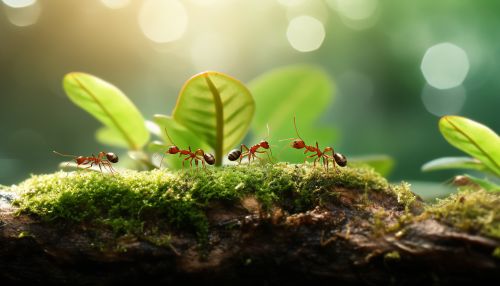Chemical Ecology of Ant-Plant Mutualism
Introduction
Chemical ecology is a branch of ecology focusing on the role of chemical interactions between living organisms and their environment. One of the most fascinating examples of chemical ecology in action is the mutualistic relationship between ants and plants, a subject that is both complex and intriguing. This relationship, known as ant-plant mutualism, is a fine example of how nature's intricate web of interactions can lead to the co-evolution of species.
Ant-Plant Mutualism
Ant-plant mutualism is a type of symbiotic relationship where both ants and plants benefit from their interaction. The nature of this relationship is primarily based on the exchange of resources and protection, with each party providing something the other needs.


Benefits to Ants
Ants involved in this mutualistic relationship gain access to food and shelter from the plants. Many plants produce food bodies, known as Beltian bodies, specifically for the ants. These food bodies are rich in lipids and proteins, providing a valuable food source for the ants. Some plants also produce nectar from extrafloral nectaries, which are not involved in pollination but serve to attract and feed ants.
In addition to food, ants also gain shelter from the plants. Many plants in this mutualistic relationship have evolved structures known as domatia, which are essentially hollow spaces within the plant that ants can inhabit. These domatia provide a safe and secure home for the ants, protecting them from predators and environmental conditions.
Benefits to Plants
In return for the food and shelter, ants provide several benefits to the plants. One of the primary benefits is protection from herbivores. Ants are known for their aggressive behavior and will attack and deter herbivores that attempt to feed on the plant. This protective behavior can significantly reduce the amount of damage a plant receives from herbivores.
Ants also provide a form of indirect nutrient supplementation to the plants. As ants consume the food bodies and nectar, they produce waste that is rich in nutrients. This waste, often deposited on or near the plant, can be absorbed by the plant and used to supplement its nutrient intake.
Chemical Ecology in Ant-Plant Mutualism
Chemical signals play a crucial role in the establishment and maintenance of ant-plant mutualism. Both ants and plants produce a variety of chemical compounds that facilitate their interaction.
Chemical Signals from Plants
Plants involved in ant-plant mutualism produce a variety of chemical signals to attract and maintain their ant partners. These signals can be in the form of volatile organic compounds (VOCs) that are released into the air, or they can be present in the food bodies and nectar that the plants produce.
VOCs are often used to attract ants to the plant. These compounds can be specific to certain ant species, ensuring that the plant attracts the right kind of ant. Once the ants are attracted to the plant, the chemical signals in the food bodies and nectar serve to maintain the relationship. These signals can include specific nutrients or other compounds that are beneficial to the ants.
Chemical Signals from Ants
Ants also produce chemical signals that can affect the plant. These signals can be in the form of pheromones that the ants release, or they can be present in the waste that the ants produce.
Ant pheromones can have a variety of effects on the plant. Some pheromones can stimulate the plant to produce more food bodies or nectar, ensuring a steady food supply for the ants. Other pheromones can affect the plant's growth and development, potentially influencing the formation of domatia.
The waste produced by ants is also rich in chemical signals. As mentioned earlier, this waste can provide a nutrient supplement for the plant. However, the waste can also contain other compounds that can affect the plant's growth and development.
Examples of Ant-Plant Mutualism
There are numerous examples of ant-plant mutualism in nature, each with its unique characteristics and intricacies. Some of the most well-known examples include the relationship between the bullhorn acacia tree and Pseudomyrmex ants, and the relationship between the Macaranga tree and Crematogaster ants.
Bullhorn Acacia and Pseudomyrmex Ants
The bullhorn acacia tree, also known as Acacia cornigera, has a mutualistic relationship with Pseudomyrmex ants. The tree provides the ants with food in the form of Beltian bodies and nectar, and shelter in the form of domatia. In return, the ants protect the tree from herbivores and help to prune away competing vegetation.
Macaranga and Crematogaster Ants
The Macaranga tree has a mutualistic relationship with Crematogaster ants. Similar to the bullhorn acacia, the Macaranga tree provides food and shelter for the ants. However, the Macaranga tree also produces a sticky substance that the ants use to construct their nests. In return, the ants protect the tree from herbivores and help to spread the tree's seeds.
Conclusion
Ant-plant mutualism is a fascinating example of how chemical ecology can shape the relationships between organisms. Through the exchange of resources and protection, and the intricate web of chemical signals, ants and plants have developed a relationship that is mutually beneficial and has led to the co-evolution of species. This relationship showcases the complexity and beauty of nature's interactions, and the important role that chemical ecology plays in understanding these interactions.
